A SEAN CONNERY BIRTHDAY TRIBUTE: Dr. Fate, Dr. Light, Dr. Mid-Nite, Dr… No?

—
UPDATED 8/25/25: The late Sean Connery was born 95 years ago! This piece first ran in 2017 but it obviously holds up just as well today. For more Connery features, click here! — Dan
—
It’s REEL RETRO CINEMA — where columnist Rob Kelly takes new looks at old flicks — and their comic-book adaptations! Now, Rob is also a podcaster and this week on The Film and Water Podcast — part of The Fire and Water Podcast Network — he’s put together an episode on the first and, in my mind, greatest James Bond film of them all — Dr. No. Coinciding with that, he’s written this piece on the movie and its relatively rare comics adaptation. You can click here for his podcast.
BONUS! For 13th Dimension’s official, unassailable TOP 13 BOND MOVIES OF ALL TIME, click here.

—
By ROB KELLY
Every James Bond fan has their favorite film of the series. Even casual moviegoers can rattle off a few of the more famous installments: Goldfinger. Live and Let Die. Casino Royale. But for whatever reason, 1962’s Dr. No, the first Bond film, tends to not show up on many “all-time great” lists. There are probably a couple of reasons for this but, make no mistake, Dr. No is a fantastic movie.
The film’s producers, Harry Saltzman and Albert R. Broccoli, picked Ian Fleming’s book (the sixth in the series) as the first cinematic Bond adventure mostly out of budgetary concerns: the story mostly takes place in just two locations (England and Jamaica). which would ensure they could keep costs down, and the plot was straightforward. They hired relatively unknown actor Sean Connery to play 007, and gave Terence Young, a director they had worked well with before, the job of bringing the world of James Bond to the silver screen.
Many people think of Goldfinger as the, er, gold standard of Bond films, and in many ways that’s true: It’s the first film of the series that featured many of the trappings that would come to define it, if not the entire spy genre. There’s a colorful super-villain, a henchman with a gimmick, a memorable title song. Goldfinger marks the point where the Bond series started being influenced by itself, but nevertheless many of the things we love about James Bond movies are present in Dr. No.
First up is a colorful title sequence, designed by Maurice Binder. Usually spy films were reserved affairs, but the quick cutting and bold colors indicate Dr. No will be something different. The rapid cutting continues into the film’s first scene, when the “Three Blind Mice” (a trio of assassins pretending to be blind men) kill a British intelligence officer and drag his body away. This gets MI6 involved, and they assign 007 to the case.
When we first meet Bond, it’s in a series of shots that just show his hand, the back of his head, the cards he’s playing, and of course we hear the famous voice, building our sense of anticipation. When we get our first full-on shot of Connery as Bond, he’s already at ease in the role: He’s taking all this seriously, but not too seriously. Case in point, when we meet the first “Bond Girl” (as in, a fabulously beautiful woman who only has eyes for Bond) she introduces herself as “Trench, Sylvia Trench.” Bond responds in a slightly mocking manner with “Bond, James Bond” and boom! We’ve got a catchphrase that will soon become globally recognizable as code for unflappable cool.
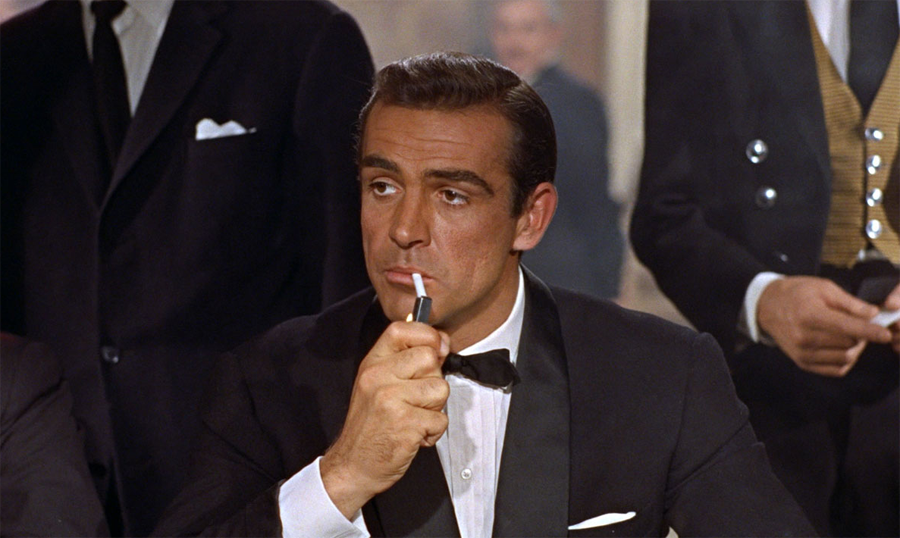
Bond’s investigation reveals that that the British officer was killed because he was on a case concerning the radio jamming of rocket launches from Cape Canaveral. The trail leads to Jamaica and Bond finds a boatman named Quarrel (John Kitzmiller) who is assisting CIA agent Felix Leiter (Jack Lord) on the mission. Traces of radioactivity have been found in some nearby rocks, which came from a secluded island called Crab Key. Bond is nearly assassinated when someone puts a tarantula in his bed, but our hero escapes in the nick of time.
When Bond arrives in Crab Key, he meets the stunning Honey Rider (Ursula Andress, in one of the great character reveals in cinema history) who is there collecting shells. She decides to help Bond on his mission (because he’s James Bond!) and after almost being killed by mechanized tractor with an attached flamethrower they are kidnapped by the titular Dr. No. (Quarrel isn’t so fortunate.)
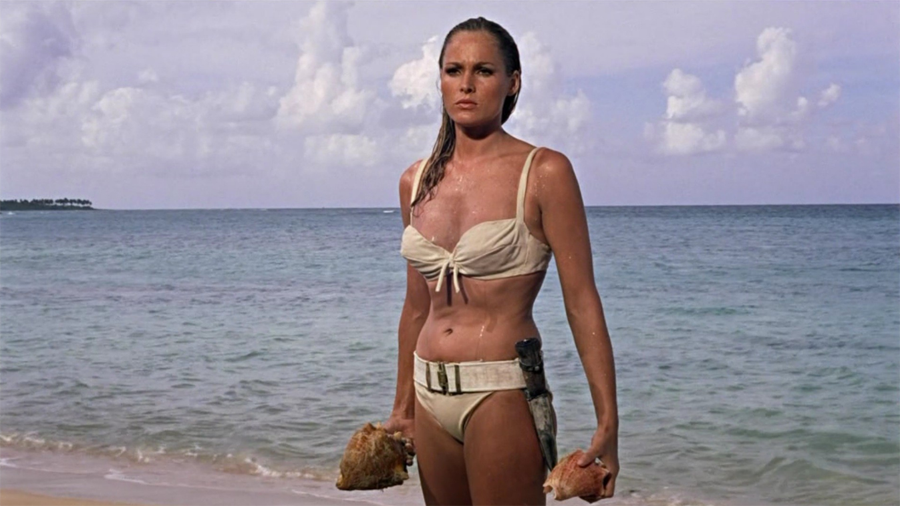
Dr. No (Joseph Wiseman) is a member of the criminal enterprise SPECTRE. He plans to disrupt a space launch from his super-cool underground lair, but Bond and Rider escape and throw a monkey wrench into the whole thing, ending with Bond and Dr. No in a fight to the death over a giant pool of boiling, irradiated water. Guess who wins?
While Dr. No still contains traces of the more dry, stiff upper lip British spy films of the 1950s, it throws in enough bold, exciting, never-before-seen elements that made the series stand out. Connery’s Bond is a mean SOB, clearly caring little for anyone or anything except the mission. He sleeps with a potential double agent literally just to kill time (we see him check his watch before the act), handing her off to the authorities afterward. When confronted with a photographer who’s been taking pictures of him, he threatens to have her arm broken until she reveals certain information. Sure, he’s on the right side, but this James Bond is not a guy you’d want to cross.
Ursula Andress, as Honey Rider, is impossibly sexy, with her white bikini and hunting knife. As I mentioned with the opening sequence, the colors in the film are bold and brash, popping off the screen like a comic book (more on that in a moment). Dr. No’s lab, with its army of helmeted henchmen scurrying around, is reminiscent of numerous comic book super-villains who somehow manage to find goons to work for them, despite the fact they will most likely die violently by story’s end. I guess the pay is good?
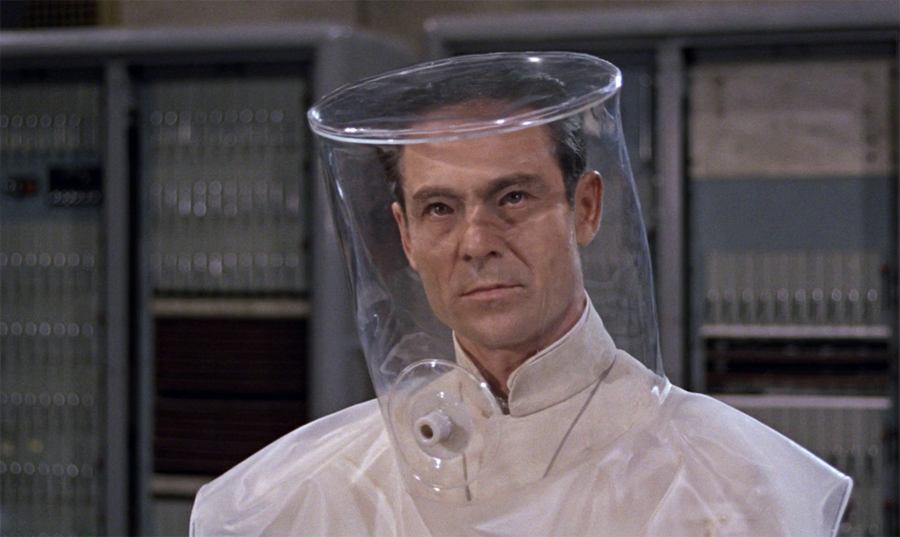
As of this writing, all the Bond films are on Hulu, and I decided to go back and “run the series.” Instead of just rewatching the ones I know are my favorites, I started from the beginning. And even I though I had seen Dr. No before, a few times actually, it had been a while since I had watched it. I always thought of the movie and its follow-up, From Russia With Love as dry, almost boring affairs, until the series really kicks into gear with Goldfinger. But that’s not true at all: Dr. No is a crackling good time, and it was a thrill to see so much of cinema history created right before my eyes.
Audiences at the time must have felt the same, because Dr. No was a big hit at the box office. Bond creator Ian Fleming’s initial doubts about the casting of Connery were summarily swept away, leading the author to start changing the character in the books to line up more with the now-world famous cinematic interpretation. James Bond would soon become a cash cow for everyone involved: the movie studio, the producers, the leading man, and the gaggle of licensors who lined up to get in on the action. That is, except for the comic-book industry.
The comic book adaptation of Dr. No was produced by the British publisher of Classics Illustrated, as part of that long-running series. They wanted it published in America, too, when the movie was scheduled to be released a few months later. The American Classics Illustrated distributed their books through classrooms and other educational outlets, not newsstands, and considered the decidedly non-educational Dr. No a poor fit. So they sold the rights to Independent News, which was owned by the same company that owned… DC Comics.
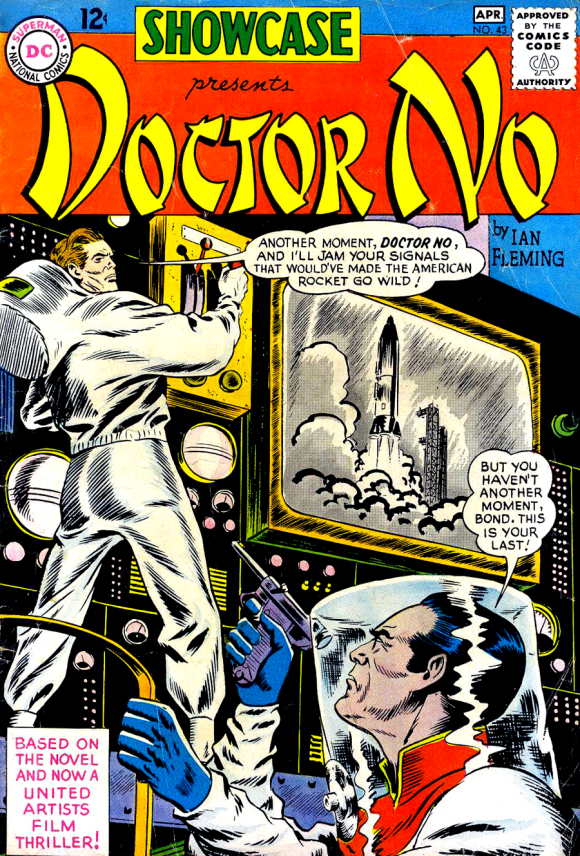
The adaptation was published, lock, stock, and Walther PPK in DC’s omnibus title Showcase, Issue #43, cover dated April 1963, in between try-out issues of Tommy Tomorrow and the Planeteers. The only alteration made was a new cover by Bob Brown that doesn’t even mention James Bond in total.
For any kid who regularly read DC Comics at the time, this issue of Showcase was downright weird. The artwork (by Norman J. Nodel) didn’t look like anything DC was publishing at the time, the book had no ads, and all the lettering was typeset. It doesn’t appear that the people who produced it ever actually saw the movie (which was a distinct possibility) and it is sterile to the point of being inert. All of the style, swing and sex of the movie is completely absent, leaving the reader neither shaken nor stirred.
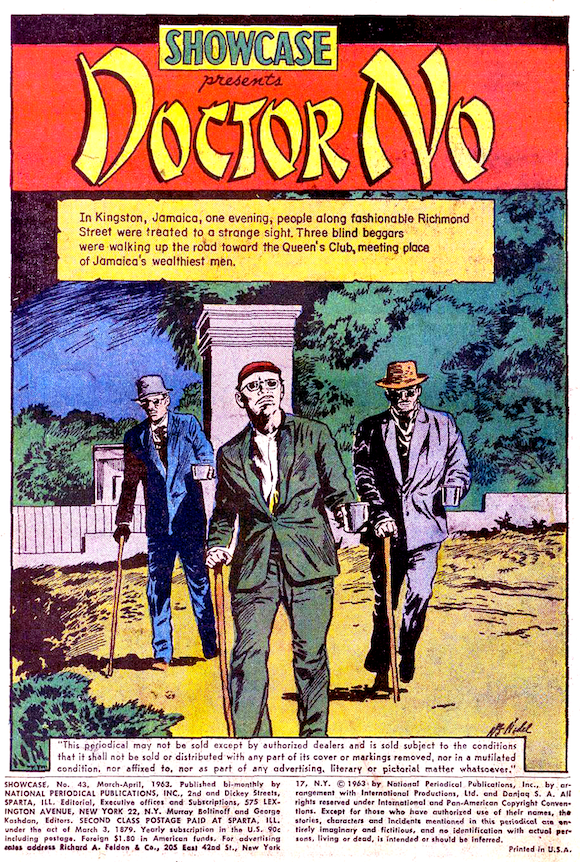
To make matters worse, the comic was released in January, a full five months before the film hit U.S. movie theaters, so no kid would have known who the hell any of these people are! Basically, Dr. No the comic sank like a stone, and DC went back to their normal state of affairs. What’s so heartbreaking about this is, along with publishing the adaptation, DC was given the rights to publish a James Bond comic for an additional 10 years — and it never happened.
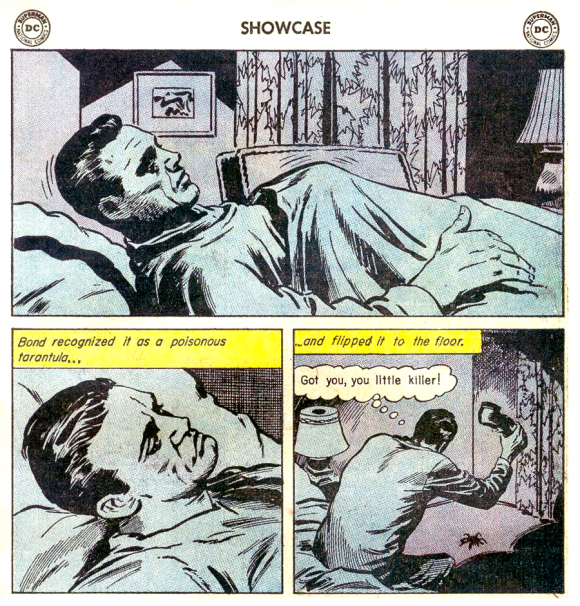
According to Mark Evanier, who wrote about this on his blog in 2006, it wasn’t until someone noticed in 1972 — when the rights were about to expire — that DC even realized they had them in the first place! So while later installments Goldfinger and Thunderball were going on to mega-grosses, turning James Bond into a 1960s icon, DC could have put out a tie-in comic book that probably would have outsold Superman and Batman combined.
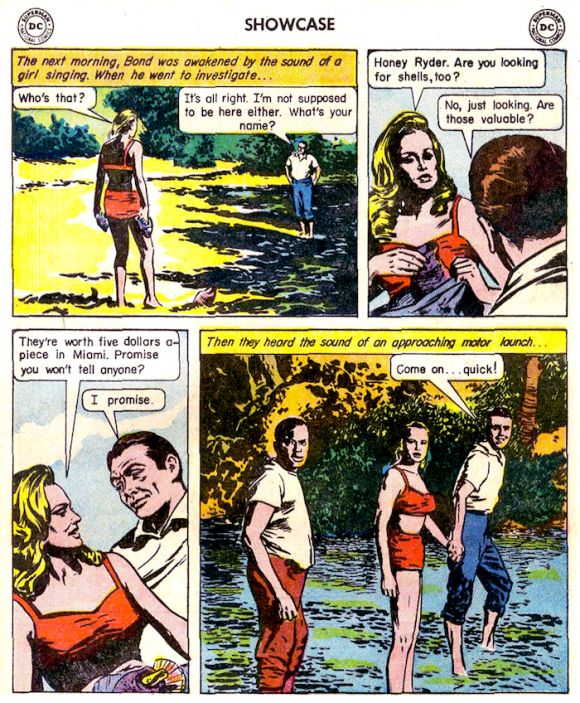
To twist the knife even further, apparently DC spoke with both Jack Kirby and Alex Toth — Jack Kirby and Alex Toth — about maybe doing a James Bond comic in 1972, but eventually passed on the whole idea. Sean Connery had formally given up the role after 1971’s Diamonds Are Forever, so they thought that the James Bond concept was on uncertain ground and probably wouldn’t work as a comic book. So DC let the rights expire, putting their efforts towards more surefire hits like Weird Mystery Tales, Date with Debbi and Larry Harmon’s Laurel and Hardy. I don’t know how to get to the parallel world where DC published an Alex Toth James Bond comic book, but I know I want to go to there.
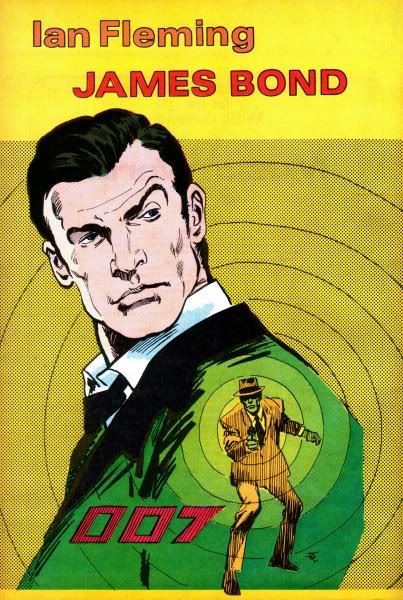
Or even… Aparo, Jim Aparo?
For some unfathomable reason, no one else seemed to think James Bond would make a good comic book either (must have been all the spying, action/adventure, and sex; kids hate that stuff), because there was not another American James Bond comic until Marvel adapted For Your Eyes Only in 1981, which we covered on Reel Retro Cinema here. The imagination, well, reels at what comics could have been made from Bond films like Thunderball, On Her Majesty’s Secret Service and The Spy Who Loved Me. That contract DC signed in 1962 gave them the world, but sometimes the world is not enough.
—
MORE
— 13 GREAT POSTERS: A SEAN CONNERY Birthday Salute. Click here.
— THE TOP 13 BOND MOVIES OF ALL TIME. Click here.
—
Rob Kelly is a writer/artist/comics and film historian. He is the co-host of Aquaman and Firestorm: The Fire and Water Podcast, the host of The Film and Water Podcast, and the host of TreasuryCast, a show devoted to the greatest comics format of all time, the treasury edition. His favorite Bond film is For Your Eyes Only.

August 25, 2020
“From Russia With Love” a dry, almost boring affair? Well, to each his own, but I personally find it to the best of the series and there are many think the same. “Russia” has a fairly realistic plot grounded in the Cold War – stealing a decoding machine and assisting a defector is something a real spy does. It is also one of the few in the series where Bond acts likes a genuine, accomplished spy…as opposed to say, “Goldfinger” where Bond blows his cover in the first 5 minutes to bed a girl…and gets her (and later, her sister) killed.
August 25, 2020
Yeah, I understand the respect the movie gets. It was my Dad’s favorite too. I just prefer that fine line between bombastic and over-the-top. Give me a hollowed-out volcano any day…
August 25, 2020
So the “DC did something stupid today” meme had its DNA extend back into the 1960s?
October 31, 2020
DC Didn’t just change the cover. They removed all non-caucasians from the book! First a translation of the original Classics Illustrated, second DC’s version.
https://images.squarespace-cdn.com/content/v1/5aedd3c72971149a59a49bfb/1527866865857-UO4OX3NRGCVKR0B3BNLQ/ke17ZwdGBToddI8pDm48kHTNTTt3In0S0B09AHToXDt7gQa3H78H3Y0txjaiv_0fDoOvxcdMmMKkDsyUqMSsMWxHk725yiiHCCLfrh8O1z5QPOohDIaIeljMHgDF5CVlOqpeNLcJ80NK65_fV7S1URWSAGx5Ws9pA9mSReF0hBilU_UD9Tk0J2OWwp17xU5flZKtLIjH2wwwSeWmNyrTOg/Detektivserien-nr-6-DR-NO-side-14-2.jpg
https://images.squarespace-cdn.com/content/v1/5aedd3c72971149a59a49bfb/1527866884137-7WRVJDGBQF2ZBLYTMGWB/ke17ZwdGBToddI8pDm48kLQkklGpyrIE92v4v6TJ9UN7gQa3H78H3Y0txjaiv_0fDoOvxcdMmMKkDsyUqMSsMWxHk725yiiHCCLfrh8O1z5QPOohDIaIeljMHgDF5CVlOqpeNLcJ80NK65_fV7S1UUMPq-UqLHNMvbVi8Hm4v2BKxp8O3yyaa_pFs5wE9mkmaxWHsOZ9Sp5tdeSL6PL17g/dr-no-comic_Page_16.jpg
August 25, 2021
Great article. I can’t believe DC passed on ten years worth of Bond adventures.
August 27, 2021
There were great bond comics published in South America and Europe. As usual DC was asleep at the wheel…yet another imaginary story..
August 25, 2025
Fascinating stuff, nice one Rob.